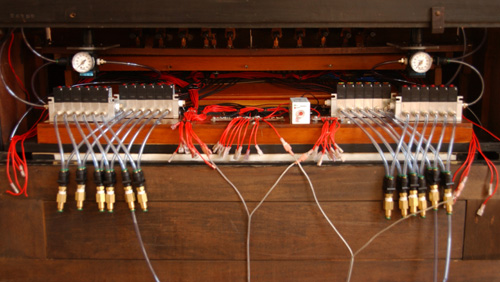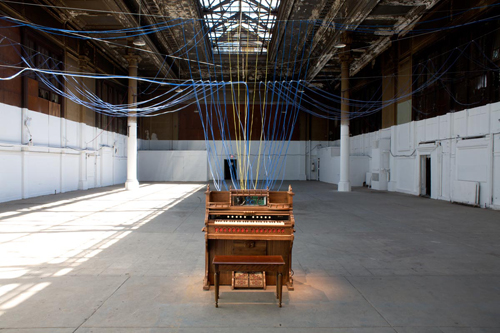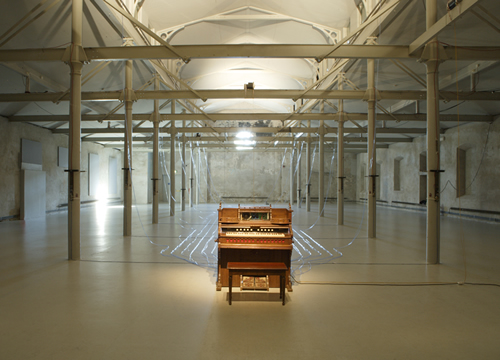



“Playing the Building” by David Byrne is a sound installation in which the infrastructure, the physical plant of the building, is converted into a giant musical instrument.
Devices are attached to the building structure — to the metal beams and pillars, the heating pipes, the water pipes — and are used to make these things produce sound. The activations are of three types: wind, vibration, striking.
The devices do not produce sound themselves, but they cause the building elements to vibrate, resonate and oscillate so that the building itself becomes a very large musical instrument.

David Byrne, co-protagonist and soundtrack writer for the new Paolo Sorrentino’s movie, “This Must Be The Place” (also the name of one of Byrne’s Talking Heads’ songs), starring Sean Penn, told about the installation:
“A few years ago I was invited to do an exhibition at a place called Färgfabriken in Stockholm—a Kunsthalle in a former factory. I went and looked at the space and later made a menu of proposals that ranged from conventional stuff on walls to a giant microwave oven to a facial recognition software piece to the project that got presented—Playing the Building.
Being an old factory, Färgfabriken has the typical physical structure of that kind of architecture—metal supports for the roof, plumbing and, in this case, cast metal columns for support. I had an idea that these typical parts of buildings could be used to produce (interesting) sounds. Everyone is familiar with the fact that if you rap on a metal column, for example, you will hear a ping or a clang, but I wondered if the pipes could be turned into giant flutes, and if a machine could make some of the girders vibrate and produce tones. After thinking about how girders vibrate when a truck or a train goes over a metal bridge, it seemed just a matter of working out the mechanics of playing a building.
Jan Åman, the director of Färgfabriken, liked this idea best, or it seemed the most feasible to him, so I proceeded to see what might be involved, and did some research back in New York with my team. I discovered that some of the arrangements for mounting the machines on the parts of the building would have to be fabricated, but most of the other materials could be obtained off the shelf. I happened to have an old pump organ in my studio that I’d inherited from Jean-Yves Noblet’s former print studio. It worked well enough as an organ but its tuning was slightly off from 440, so it wasn’t destined for a recording studio. I realized that its antique body and keyboard would make the perfect controller for this piece—it would emphasize the Victorian steam-punk technology at work here as well as the simplicity of this completely mechanical acoustic piece. There are no microphones, no amplification, and none of the sounds are synthesized or altered electronically. The organ keyboard basically serves as a series of switches at the back of the organ, which is left open so people can see the workings.”

EXHIBITION HISTORY:
• Playing the Building, Roundhouse, London, UK, 8–31 August 2009
• Playing the Building, presented by Creative Time, Battery Maritime Building, New York, NY, 31 May–24 August 2008: Winner, 2008 AICA (American Section of the International Art Critics Association) award for Best Show in a Public Space
• Playing the Building, Färgfabriken, Stockholm, Sweden, 8 October–13 November 2005
RECORDINGS:
2008:
• Watch/Listen to a video recording of the installation in the Battery Maritime Building
• Listen to Robert Gomez‘s “Hunting Song”, composed with his sampled recordings from the installation
• Download a sampler of all the sounds recorded onsite in August 2008 by Noel Benford and Rob Serafin: ReFill package (55MB; requires Reason 4.0 for use.) Thank you Noel & Rob!
2005:
• Watch/Listen to a phonecam video recording of the installation in Stockholm
• Listen to an audio recording of visitors playing the building
• Listen to an audio recording of Andrew Drown playing the building
• Listen to an audio recording of Ewa Berglund playing the building

PRODUCTION:
2009: Production Manager: Mark McNamara; Systems Engineer & Head of Fabrication: Justin Downs; Fabrication: Brett van Aalsburg, Eric Singer; Project Manager: Danielle Spencer.
2008: Curator: Anne Pasternak; Project Manager: Danielle Spencer; Production Manager: Mark McNamara; Systems Engineer & Head of Fabrication: Justin Downs; Fabrication: Brett van Aalsburg, Eric Singer; Crew: Nick Emmett, Eric Dyer; Producer for Creative Time: Gavin Kroeber.
2005: Engineering: James Case, Justin Downs + Arun Nair; Production assistance: Joel Raif, Matti Molin. Project Manager: Danielle Spencer. Coördination for Färgfabriken: Emma Karlsson.
by Ilaria Rebecchi